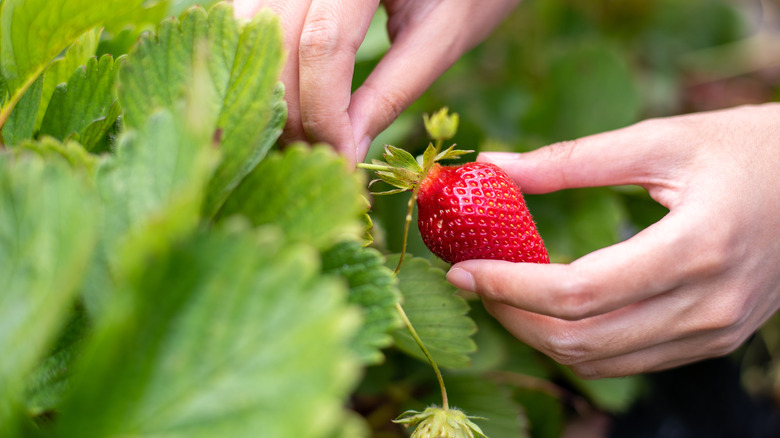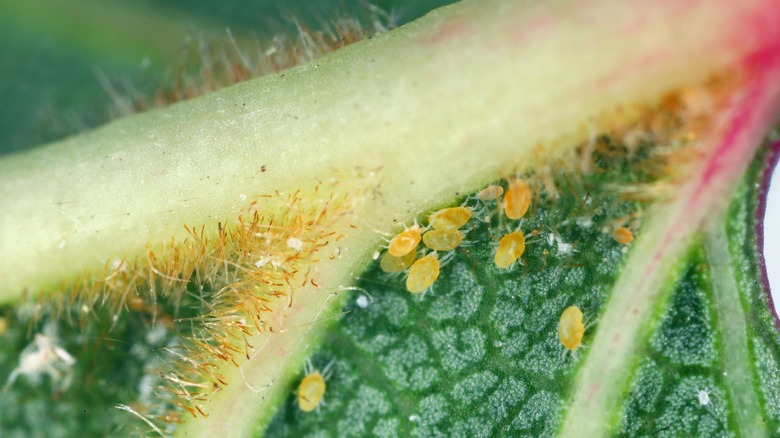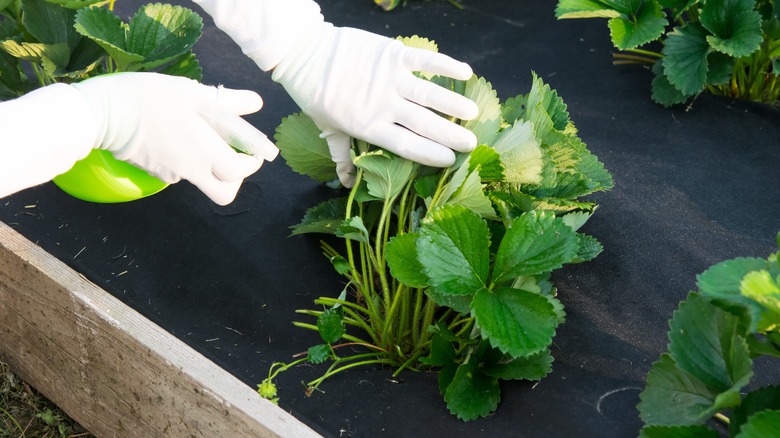Our Best Tips For Identifying And Eliminating Spider Mites On Strawberry Plants
Strawberry plants can be some of the most enjoyable types of garden crops to grow. They don't require a lot of space or much hands-on attention. However, for success, you'll need to keep them pest-free, which means knowing how to identify and eliminate the spider mite, one of the most common pests to cause damage to these plants.
These pests are a rather common type of insect often found in fruit trees and plants, but spider mites can live indoors, too. They are very small and easy to miss as a result. A type of arachnid, these tiny pests look like nothing more than a white dot on a plant — easily thought to be dust or debris. When growing strawberry plants, they are most likely lurking on the underside of the leaves, which makes it even harder to determine their presence, which can be detrimental. On strawberry plants, spider mites will suck the contents from the leaves' cells, which creates damage. A few mites may not be problematic for an otherwise healthy plant. However, a large infestation can create significant damage, leading to limited fruit production and even spread to other plants in the area. There are numerous methods of control available, including using insecticidal soaps and spraying them directly. It's also important to keep plants healthy both to ward off the presence of spider mites and give them a fighting chance at recovery.
What spider mites look like
It's hard to notice spider mites with the naked eye. Typically, the only thing you'll notice are white dots that, when you watch them for a moment, seem to move. If you could see them under a microscope, you would see they look like spiders. Their oval bodies have eight legs coming off of them. You'll also notice that their tiny bodies seem to have two dots towards the end of the head. Those are the eyes. Incredibly, adults are only 1/20 of an inch in size. That makes juveniles very difficult to spot at all. You may not notice spider mites on your strawberry plant until the infestation gets larger — as they tend to live in colonies — with a healthy colony consisting of hundreds of spider mites.
To find out if spider mites are lurking on your strawberry plants, turn over the leaves. Preferring the shade, these pests are most likely lurking towards the stem or on the underside of the larger leaves. You may notice some webbing developing in this region as well. This is typically where you'll find small, round, and translucent eggs — though you typically cannot see these without magnification. As they get older, they turn a pale green or a burnt orange color. Also, note that spider mites thrive in dryer conditions. If your strawberry plants have dried out significantly due to a lack of rain, they're more likely to attract these pests.
How to control spider mites on your strawberry plants
Now that you've noticed them on your strawberry plants, the good news is you can often get rid of spider mites effectively in a few steps, and when caught early enough, your plants should survive. First, start by watering the plants to discourage the pests from lurking around. Keep the soil moist and properly draining to support the strawberry plant's recovery, too. The next step is to attract the predators of spider mites, including thrips and lacewings. That should keep the population under control without damaging the plants.
Most insecticides will work well to control large infestations of spider mites. Insecticidal oils or soaps tend to work the best. For strawberry plants, use these products in a spray bottle and lightly mist the underside of each leaf directly where the mites may be lurking. Only do this if you're confident the plants are not stressed from a lack of water, as the insecticide could stress the plant more.
To avoid using insecticides, spray the underside of the leaves with plain water, which will work to deter spider mites to some degree. Aim to do this at least once a day. You also want to minimize the dust in the area since this encourages the mites. Place mulch or fabric around the base of the plants to create a break between the soil and the leaves. With careful attention to this infestation, your plants should recover steadily.


